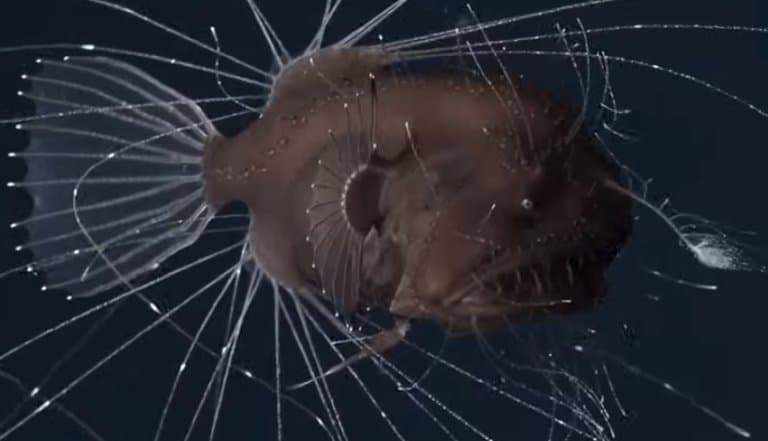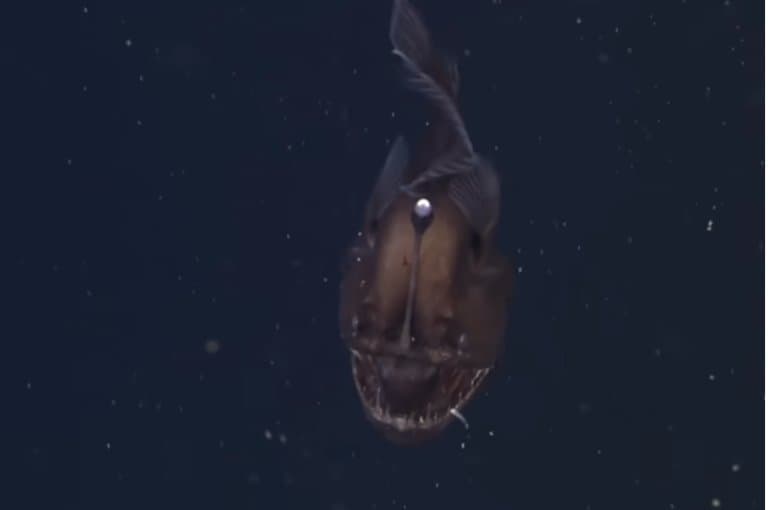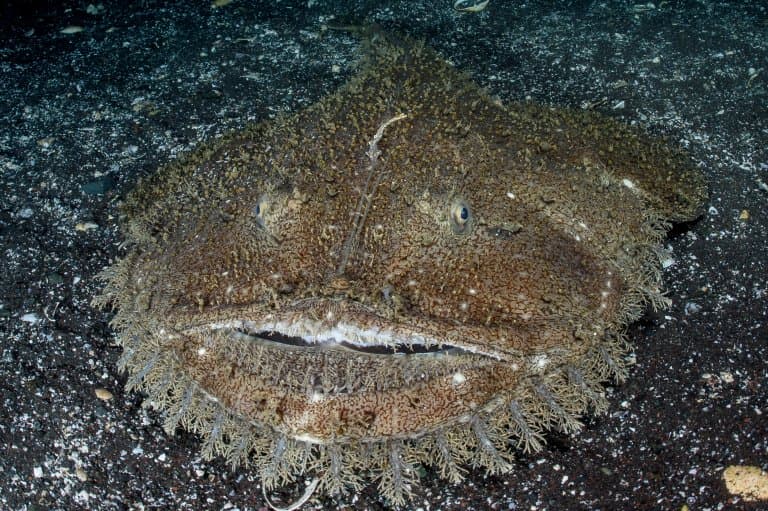Anglerfish Profile
Anglerfish are group of bony fish which are known for their unique adaptation for catching prey: the first spine of their dorsal fin acts as a fishing rod with an attractive luminescent lure dangling at the end to attract prey.

Anglerfish Facts Overview
| Habitat: | Diverse oceanic habitats: sea floor; coral reefs; open waters |
| Location: | Worldwide, with some species found in specific localities |
| Lifespan: | 25 to 30 years for females, up to 21 years for males |
| Size: | Females of different species can grow from 18 to 100cm long. Males are much smaller |
| Weight: | Up to 50kg |
| Color: | Dark grey to dark brown |
| Diet: | Carnivorous, feeding on small fish and crustaceans |
| Predators: | Humans |
| Top Speed: | Slow swimmers |
| No. of Species: | 200-300 |
| Conservation Status: | Common species are of Least Concern, rarer species Threatened |
Anglerfish fall into two main types: those which inhabit the deepest and darkest ocean waters and therefore are rarely seen by people; and those which swim in well-lit, surface waters in temperate and tropical regions.
This piece focuses mostly on deep-sea species with their bizarre and marvellous adaptations to life in a world, with little or no sunlight and limited sources of food.
Interesting Anglerfish Facts
1. Anglerfish have a huge head, a vast mouth, and a flattened body
All anglerfish are carnivorous, so their adaptations all help them catch prey. But there are differences detween the surface living and deep-sea species.
Deep-sea anglerfish that live close to the sea floor are flattened dorso-ventrally, like a plate on a table, with the mouth facing upwards.
Those in upper waters are flattened laterally, with the mouth facing forwards. 1

2. They are all strictly carnivorous
It feeds on other fish, snails, and crustaceans, such as shrimps.
4. Anglerfish have long, fang-like teeth
Its sharp teeth point inwards to grip the prey it catches.
Incredibly, the jaw and stomach of anglerfish can extend to allow it to consume prey up to twice its own size.
This is because of the low food source environment anglerfish live in, meaning they can store food in their stomachs.
5. Anglerfish grow their own angling rod from the fin on its back
The first spine of the dorsal fin modifies as the anglerfish grows, becoming a rod-like appendage dangling above its body. 2
6. Their angling rod is controlled using muscles at the base of the fin
This helps to attract the attention of prey fish. 3
7. Its lure glows in the dark
Deep-sea anglerfish have a lure (called an esca) that contains bioluminescent bacteria, which live in the complex structure at the end of the rod. 4The fish benefits from the glow which attracts prey, while the bacteria gain shelter and nutrients.
8. It can either hide or reveal its lighted lure
It has a muscular skin flap which can cover the lure, and it can pulse the light to attract prey. 5
9. Each species of anglerfish hosts a different species of bacterium
There are different theories about how light-producing bacteria get inside the lure: some suggest they are already luminescent when they enter from surrounding seawater, while others propose that they are unable to luminesce until the host anglerfish changes the bacterial cell genetic make-up. 6 7
10. It has extreme sexual dimorphism, with the female being the angler
There are many differences between the male and female in species that live in deep waters. The female is large, with a huge mouth and a specialised lure.
The male remains small and does not develop a lure. Instead, it latches on to the side of the female’s body with its small, sharp teeth.
11. The male has an enhanced sense of smell to detect females to mate
In the murky waters of the deep oceans, it can’t rely on sight to find a mate, but can sniff out a mature female from a distance. 8
12. They share sexual partners
Once a female has reached sexual maturity, it may have six or more male partners attached to its body, proving a constant supply of sperm to fertilise the eggs when they are released into the water.
13. Anglerfish can become two fish in one
The male can remain attached by its mouth to the female’s body for the rest of its life, becoming a permanent appendage. It loses its own ability to live as a separate fish and can even lose its eyesight, thus relying on the female to hunt and provide nutrition via her blood.
(Note: This is not the case for all anglerfish.)
14. They use camouflage as a hunting strategy
Shallow-water anglerfish, such as frogfish, have coloration for disguise as rock or seaweed, allowing it to ambush its prey.
15. They’re a surprisingly popular source of food for humans
In Japan, shallow-water anglerfish have long been a common item on the menu.
In the UK and North America, the species Lophius piscatorius – commonly known as ‘monkfish’ – has become a popular food choice. It is found in Scottish waters and other parts of the North Atlantic Ocean and in the Mediterranean Sea.
While it did not used to be a valued catch, it now fetches a high price. 9

16. They’re vulnerable to over-fishing
All large anglerfish are sexually mature females, so when these are harvested the population can be severely depleted. 10
Anglerfish Fact-File Summary
Scientific Classification
| Kingdom: | Animalia |
| Phylum: | Chordata |
| Class: | Actinopterygii |
| Order: | Lophiiformes |
| Family: | Lophiiformes |
Fact Sources & References
- “Anglerfish”, Animals Network.
- “Anglerfish”, National Geographic.
- “Anglerfish”, Science Direct.
- Alison Eldridge, “esca anatomy”, Britannica.
- “Deep Sea Anglerfish”, Oceana.
- L.K. Ward, “Meet the Tiny Bacteria That Give Anglerfishes Their Spooky Glow”, Smithsonian.
- Lydia J Baker (2019), “Diverse deep-sea anglerfishes share a genetically reduced luminous symbiont that is acquired from the environment”, eLife Sciences.
- Emily Osterloff, “The bizarre love life of the anglerfish”, Natural History Museum.
- Kristen Coleman, “Lophius piscatorius Monkfish”, Animal Diversity Web.
- Afonso-Dias,I.P. & Hislop, J.R.G. (1996), “The reproduction of anglerfish Lophius piscatorius L. from the north-west of Scotland. Journal of Fish Biology, 49 (Supplement A), 18-39.”, Sci-Hub.
